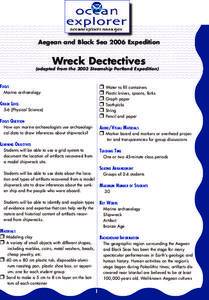Curated OER
A Line Graph of the Ocean Floor
Young scholars develop a spreadsheet and import the information into a line graph. In this spreadsheet and line graph lesson, students develop a spreadsheet of ocean depths. They import the information into a word processed document....
Curated OER
Wreck Detectives
Junior archaeologists examine types of artifacts from the Bronze Age on the internet. In collaborative groups, they create a story about a ship from this period and then construct a model of the ocean floor after their ship has sunk....
Curated OER
Oceanography
Fifth graders study the topography of the ocean floor. They determine its ever changing nature as they examine currents and trade winds. They write paragraph describing how the winds might affect land formations after the discussion of...
Channel Islands Film
Island Rotation: Lesson Plan 1
How do scientists provide evidence to support the theories they put forth? What clues do they put together to create these theories? After watching West of the West's documentary Island Rotation class members engage in a series of...
Curated OER
A Model of Three Faults
Learners investigate faults. For this science lesson, students explore the many stresses and strains in the earth's layers and research the types of faults in their state.
Curated OER
Introduce Vocabulary: I See Animals Hiding (Arnosky)
Animals are amazing at disguise! Explore the different ways they escape view as scholars learn vocabulary-in-context through Jim Arnosky's book I See Animals Hiding. Prepare pupils to raise their hands when they hear...
Curated OER
Introduce Vocabulary: I See Animals Hiding
Learners are introduced to the story " I See Animals Hiding" and define key vocabulary words from the story. In this instructional activity aimed at reinforcing vocabulary, students listen to the usage of vocabulary words in the...






